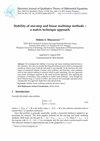Nagumo格微分方程的周期平稳解:存在区域及其数目
IF 0.8
4区 数学
Q1 MATHEMATICS
Electronic Journal of Qualitative Theory of Differential Equations
Pub Date : 2021-01-01
DOI:10.14232/EJQTDE.2021.1.23
引用次数: 2
摘要
当扩散速率足够小时,Nagumo晶格微分方程允许具有任意空间周期的平稳解。用解耦系统(孤立节点系统)的平稳解的延拓来确定它们的类型;答案由三个字母的字母表中的单词标记。每个固定的解决方案类型可以分配一个参数区域,其中的解决方案可以唯一地识别。方程中存在的许多对称性导致一些区域具有相同或相似的形状。利用组合枚举的方法,导出了定性不同存在区域数目的确定公式。我们还讨论了对其他具有更一般非线性项和/或空间结构的系统的可能扩展。本文章由计算机程序翻译,如有差异,请以英文原文为准。
Periodic stationary solutions of the Nagumo lattice differential equation: existence regions and their number
The Nagumo lattice differential equation admits stationary solutions with arbitrary spatial period for sufficiently small diffusion rate. The continuation from the stationary solutions of the decoupled system (a system of isolated nodes) is used to determine their types; the solutions are labelled by words from a three-letter alphabet. Each stationary solution type can be assigned a parameter region in which the solution can be uniquely identified. Numerous symmetries present in the equation cause some of the regions to have identical or similar shape. With the help of combinatorial enumeration, we derive formulas determining the number of qualitatively different existence regions. We also discuss possible extensions to other systems with more general nonlinear terms and/or spatial structure.
求助全文
通过发布文献求助,成功后即可免费获取论文全文。
去求助
来源期刊
CiteScore
1.40
自引率
9.10%
发文量
23
审稿时长
3 months
期刊介绍:
The Electronic Journal of Qualitative Theory of Differential Equations (EJQTDE) is a completely open access journal dedicated to bringing you high quality papers on the qualitative theory of differential equations. Papers appearing in EJQTDE are available in PDF format that can be previewed, or downloaded to your computer. The EJQTDE is covered by the Mathematical Reviews, Zentralblatt and Scopus. It is also selected for coverage in Thomson Reuters products and custom information services, which means that its content is indexed in Science Citation Index, Current Contents and Journal Citation Reports. Our journal has an impact factor of 1.827, and the International Standard Serial Number HU ISSN 1417-3875.
All topics related to the qualitative theory (stability, periodicity, boundedness, etc.) of differential equations (ODE''s, PDE''s, integral equations, functional differential equations, etc.) and their applications will be considered for publication. Research articles are refereed under the same standards as those used by any journal covered by the Mathematical Reviews or the Zentralblatt (blind peer review). Long papers and proceedings of conferences are accepted as monographs at the discretion of the editors.

 求助内容:
求助内容: 应助结果提醒方式:
应助结果提醒方式:


